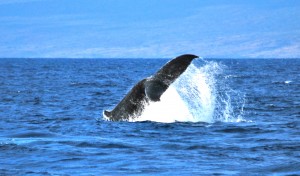Aloha,
Tag Archives: spout
Close Up Action
Aloha,
Stormy Weather Leads to a Fluke
Aloha,
Windy Weather but Plenty of Action
Aloha,
Whale Season off to a Fantastic Start
Aloha,
Windy, but we are Still Seeing Whales
Feeding Techniques of the Humpbacks
Diving, Spouting, and Tail Lobs
On Thursday, we ran two different Breakfast with the Whales Cruises from Anaeho’omalu using Seasmoke and Manu Iwa. Even though both of the boats left at roughly the same time and from the same location, guests on each got to see different activities.
Mahalo and have a great weekend!
Claire
Captain Claire’s Humpback Fact of the Day: There’s a time when a whale is still in its fetal stage that it’s covered in fur. By the time the calf is born, the fur has disappeared. Many researchers believe that this is another indication that whales have evolved from an animal with a common ancestor to a hippo. The idea that the stages of an animal’s fetal development reflect evolutionary development or “Ontogeny recapitulates Phylogeny” was first proposed by Ernst Haeckel around 1900.

